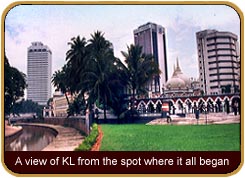From Tin Town to Tower City |
||||||||||
Few got rich, but throughout the peninsula the mania for tin inspired fierce rivalries and claim disputes. As they did in the gold fields of California, the Chinese miners organized themselves into clans and warring factions called "secret societies." Without a centralized Chinese authority keeping peace, order in the mining areas was nearly impossible. Whole clans could be swept up in fights that started over little more than a drunken dispute between two men. In 1868, needing a solution to the chaos, the headmen of the local clans elected a man named Yap ah Loy as "Kapitan China," or leader of the Chinese community. With the support of the local sultan, he built prisons and quelched revolts, quickly establishing an infamous reign over the entire Kuala Lumpur mining area. If KL has a "founding father," it is Loy. Loy had barely established control, however, when the Malay Civil War broke out a few years later. Local sultans were fighting for the throne of Perak, and KL, swept up in the conflict, burned to the ground. The merchants of the Straits Settlements, concerned that the war would ruin their prosperity, asked Britain to intervene. Britain was initially reluctant to get involved with internal politics, but rumors that the merchants would turn to Germany instead sparked a fear in London that Britain could lose its tin interests in Malaya. London sent in a new territorial governor, Andrew Clarke, to apprise the situation. Clarke gathered the feuding princes aboard his ship off the island of Pangkor, and convinced them to sign a document known as the Pangkor Agreement. The Agreement ended the war, established a new Sultan of Perak, and -- most significantly -- called for the presence of a British Resident "who must be asked and acted upon on all questions other than those touching Malay religion and custom." This was the beginning of a dramatically increased British involvement in Malaya, one that would eventually place Kuala Lumpur at center of history.
With independence, KL was poised for
its greatest transformation ever. One of the city's darkest days
came in 1969, when civil unrest - spawned by racial tensions -- swept
through the city, sparking a state of emergency that would last for
two years. Bolstered by a growing economy and a sincere desire for
cooperation between Malaysia's ethnic groups, the tensions subsided,
and in 1974 the city was given the status of Federal Territory. The
last 20 years have seen Kuala Lumpur undergo phenomenal growth, with
a population explosion of almost 50 percent, not to mention development
on a monumental scale. One of the world's tallest buildings, the
Petronas Towers, now rise above the city of 1.4 million. If those 87
Chinese
miners could have poled their way 140 years up the river of time,
they probably wouldn't recognize the legacy that began where the
two muddy rivers met.
|
|
|||||||||
Kuala
Lumpur | Malacca | Kedah | Kelantan | Perak | Negeri
Sembilan Home | Places | People | History | Nature |
||||||||||
 Near the center of Kuala Lumpur, the
Klang and Gombak rivers flow quietly together, their confluence barely
noticed amid the dwarfing skyline of gleaming new hotels and office
buildings. A few feet from the place where the rivers meet, the
Near the center of Kuala Lumpur, the
Klang and Gombak rivers flow quietly together, their confluence barely
noticed amid the dwarfing skyline of gleaming new hotels and office
buildings. A few feet from the place where the rivers meet, the 